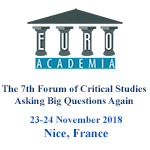Euroacademia Conferences
 Europe Inside-Out: Europe and Europeanness Exposed to Plural Observers (9th Edition) April 24 - 25, 2020
Europe Inside-Out: Europe and Europeanness Exposed to Plural Observers (9th Edition) April 24 - 25, 2020 Identities and Identifications: Politicized Uses of Collective Identities (9th Edition) June 12 - 13, 2020
Identities and Identifications: Politicized Uses of Collective Identities (9th Edition) June 12 - 13, 2020 8th Forum of Critical Studies: Asking Big Questions Again January 24 - 25, 2020
8th Forum of Critical Studies: Asking Big Questions Again January 24 - 25, 2020 Re-Inventing Eastern Europe (7th Edition) December 13 - 14, 2019
Re-Inventing Eastern Europe (7th Edition) December 13 - 14, 2019 The European Union and the Politicization of Europe (8th Edition) October 25 - 26, 2019
The European Union and the Politicization of Europe (8th Edition) October 25 - 26, 2019 Identities and Identifications: Politicized Uses of Collective Identities (8th Edition) June 28 - 29, 2019
Identities and Identifications: Politicized Uses of Collective Identities (8th Edition) June 28 - 29, 2019 The European Union and the Politicization of Europe (7th Edition) January 25 - 26, 2019
The European Union and the Politicization of Europe (7th Edition) January 25 - 26, 2019 7th Forum of Critical Studies: Asking Big Questions Again November 23 - 24, 2018
7th Forum of Critical Studies: Asking Big Questions Again November 23 - 24, 2018 Europe Inside-Out: Europe and Europeanness Exposed to Plural Observers (8th Edition) September 28 - 30, 2018
Europe Inside-Out: Europe and Europeanness Exposed to Plural Observers (8th Edition) September 28 - 30, 2018 Identities and Identifications: Politicized Uses of Collective Identities (7th Edition) June 14 - 15, 2018
Identities and Identifications: Politicized Uses of Collective Identities (7th Edition) June 14 - 15, 2018
The Relation between Cultural Tourism and Traditional Churches Art in Romania’s Country Sites
-
-

-
Presentation speakers
- Andreea Marin Pantelescu, Academy of Economic Studies, Bucharest, Romania
Abstract:
This paper focuses on the relation between cultural tourism and traditional churches art in Romania’s rural sites while investigating the foreign tourists perceptions about local customs and traditions in identity making practices. As tourism facilitates the interaction of the locals with foreign tourists, it creates also an energy of exchange and enriches cultures on both sides. UNESCO World Heritage in Romania includes now six cultural sites : Dacian fortresses in the Orăştie Mountains, Transylvanian fortified churches, churches of Moldavia, Horezu Monastery, the wooden churches of Maramureş and the historical center of Sighisoara. The Horezu Monastery represents a masterpiece of the Brâncovenesc style. An authentic image of the cultural sight in southern Transylvania country includes: the fortified church and the rural site of Biertan, the fortified churches of Prejmer, Viscri and Saschiz. Churches of Moldavia (like Arbore, Moldovița, Sucevița, Voroneț) have the exterior walls covered with authentic and well-preserved fresco paintings, which represent complete cycles of religious themes with theological message and are considered “masterpieces inspired by Byzantine art.” The theological interpretation generated by the painting of ‘The Last Judgment’ and ‘The Prayer of Ali Saints ‘ on the monasteries exterior walls has an outstanding value. Some questions arise from this presentation: how we can preserve artistic, cultural and historic sites for the future generations while sharing their uniqueness and role in identity making?; can we educate tourists to appreciate diversity and local cultures?; and how we can spread awareness about the importance of preserving sites of local or regional identity in the contemporary world?
-
Related Presentations

Made in Transit: Politics and Representation in Adrian Paci, Contemporary Art and the Migration Issue
- Pedro David Massena Carreiro

Ugliness, Kitsch and Value in Shaping Contemporary Urban Spaces
- Anastasiya Halauniova

#Got_no_other_xv_century_left_for_u”: The Negotiations of Belonging in the Communities of XV Century Reenactors in Russia
- Marina Baiduzh

Anamnesis: Dialogues of Art in Public Spaces
- Sandra Uskokovic













